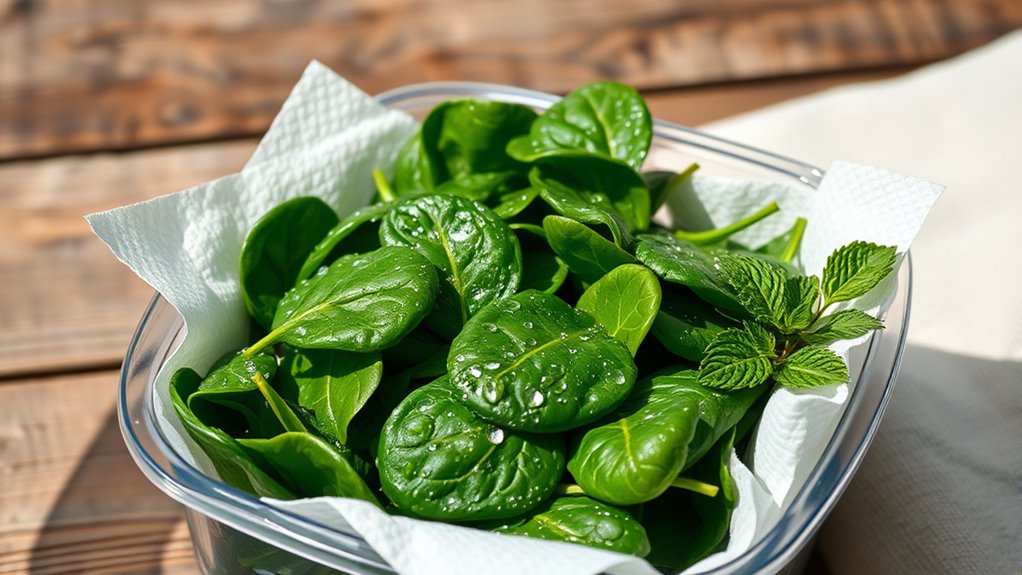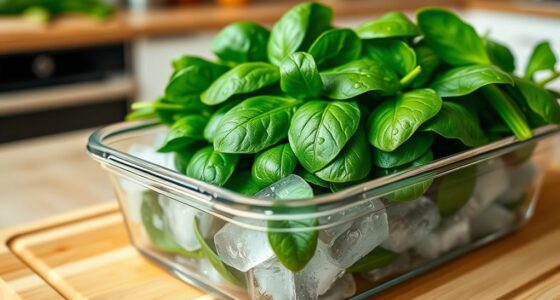To keep spinach fresh longer, wash it thoroughly, discarding any damaged leaves. Store it in the crisper drawer of your fridge below 40°F (4°C). Use breathable containers like glass or silicone, and add paper towels to absorb moisture. Keep ethylene-producing fruits separate to prevent spoilage. For long-term storage, consider freezing your spinach. These tips will help maintain its freshness and nutrients. Explore more ways to enhance your spinach storage for the best results!
Key Takeaways
- Store spinach in the crisper drawer of the refrigerator at temperatures below 40°F (4°C) to slow down spoilage.
- Use breathable containers, like glass or stainless steel, to maintain air circulation and moisture control.
- Add paper towels inside storage containers to absorb excess moisture and prevent wilting.
- Regularly check for and remove damaged leaves to prevent spoilage from spreading.
- Consider freezing spinach for long-term storage, using airtight bags or portioning with silicone muffin trays.
Understanding Spinach Shelf Life
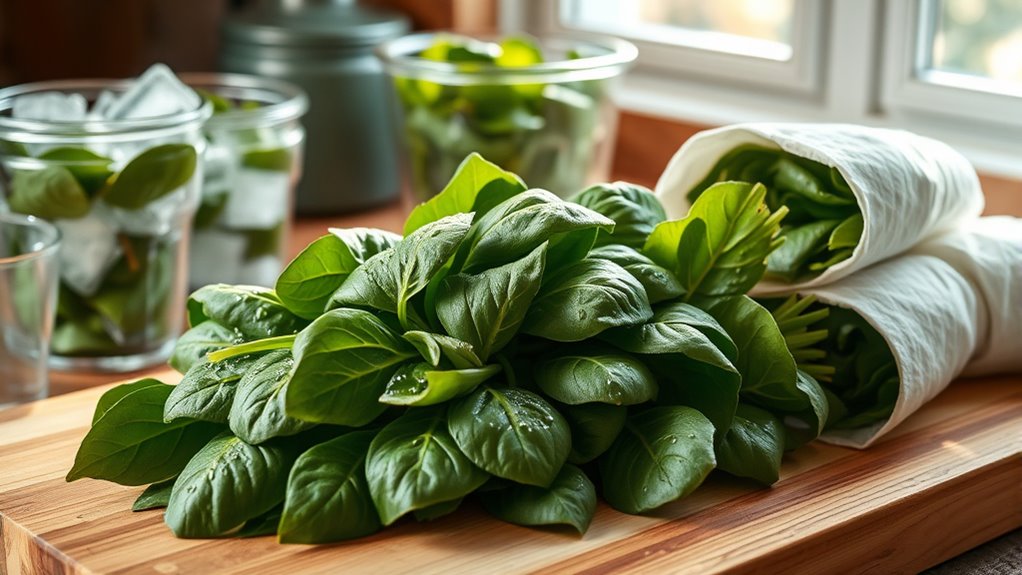
Understanding spinach shelf life is essential for keeping this nutritious green fresh and flavorful. Several factors influence how long spinach lasts, starting with temperature. You need to maintain consistent cold temperatures to slow down decay.
Knowing the factors that affect spinach shelf life, such as temperature, is key to keeping this nutritious green fresh.
Humidity matters too; moderate levels prevent sogginess. When you buy spinach, its freshness plays a crucial role in its overall shelf life. Whole leaves typically last 5-7 days in an unopened bag, while opened bags drop to 3-5 days.
Chopped spinach usually lasts just 1-2 days, and cooked spinach can last 3-5 days if stored properly. Always handle spinach gently, as the condition of the leaves affects longevity.
Regularly check for spoilage to enjoy your spinach at its best.
Proper Washing and Drying Techniques
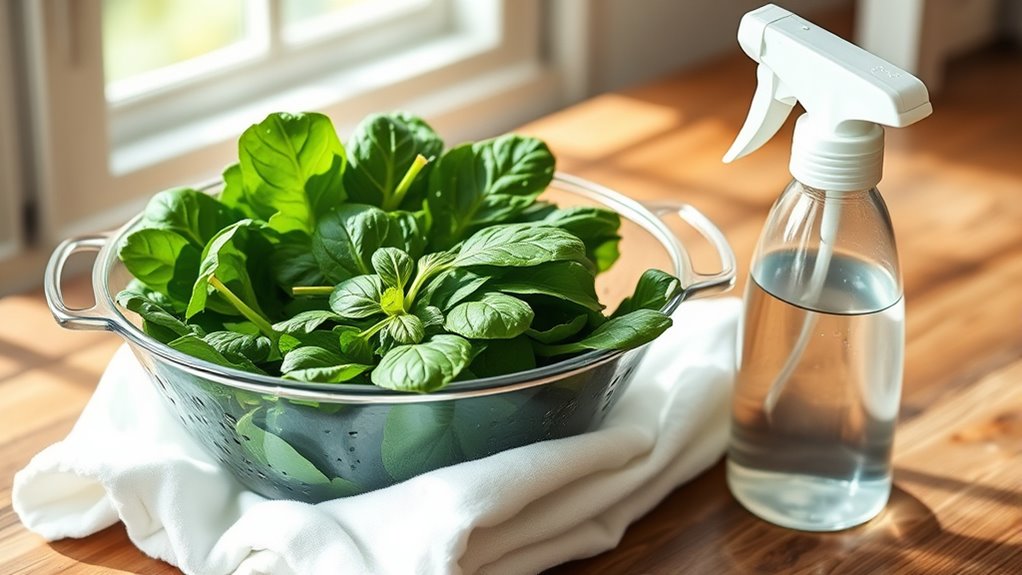
To keep your spinach fresh and crisp, proper washing and drying techniques are essential. Start by washing your hands with hot water and soap before handling the spinach to prevent contamination. Discard any damaged leaves you find.
Soak the spinach in cool water for a few minutes to loosen dirt, and consider adding vinegar to the water to kill harmful pathogens. Rinse it under cold running water to avoid wilting.
For drying, a salad spinner works best to remove excess moisture quickly. If you don't have one, lay the spinach on paper towels to absorb moisture. Avoid air drying for too long, and gently blot the leaves with a clean towel. This ensures your spinach stays fresh longer.
Best Storage Containers for Freshness
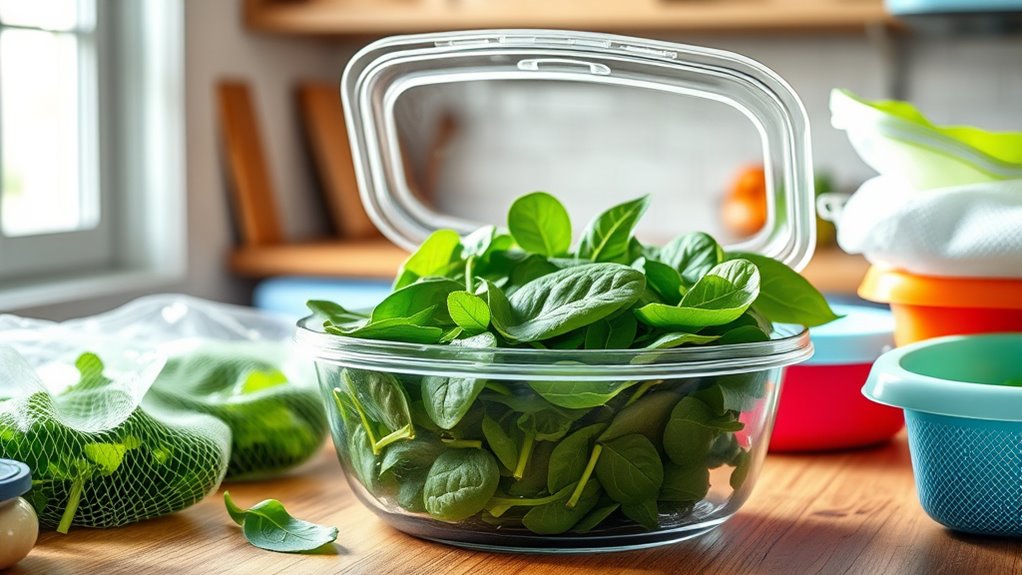
After washing and drying your spinach properly, choosing the right storage container is key to keeping it fresh.
Opt for produce keepers with ventilation and moisture control to maintain optimal humidity. Containers made of breathable materials like glass or stainless steel are ideal, and using paper towels inside can absorb excess moisture.
Remember to store ethylene-producing fruits separately to prevent spoilage. Look for stackable containers to maximize your fridge space.
Silicone produce keepers or greens keepers specifically designed for leafy greens can extend freshness and reduce waste. Brands like Progressive and GreenSaver offer effective options.
With the right container, you'll enjoy fresh spinach longer and minimize trips to the grocery store.
Refrigeration Tips for Optimal Longevity
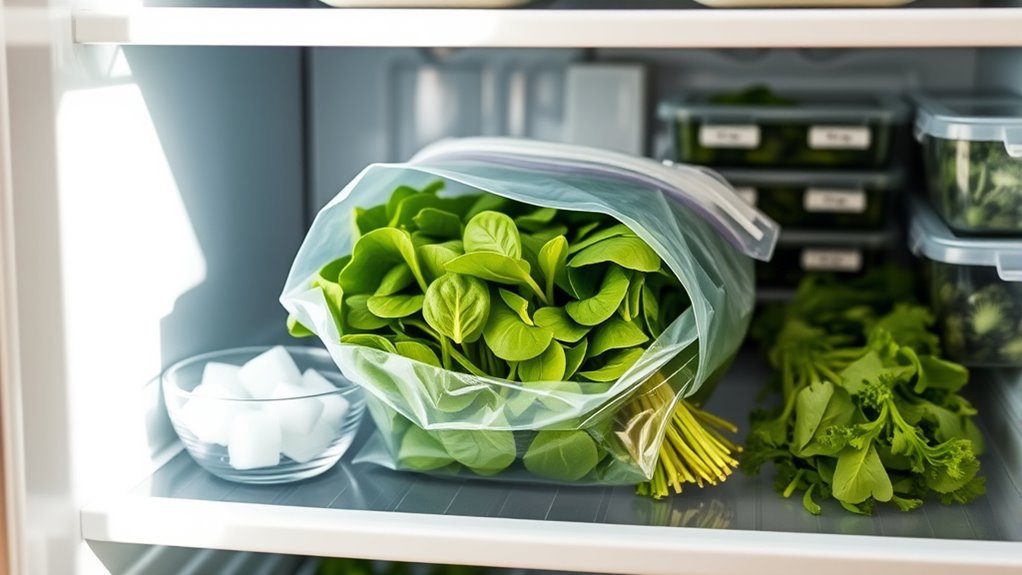
Keeping spinach fresh requires careful attention to refrigeration practices that enhance its longevity. Store your spinach in the refrigerator at a consistent temperature below 40°F (4°C) to slow spoilage.
Use the crisper drawer to maintain optimal humidity while avoiding excess moisture that can lead to rot. Regularly inspect your spinach, removing any damaged leaves to prevent spoilage from spreading.
For moisture control, dry your spinach thoroughly after washing, and place it in breathable materials like paper towels. Avoid storing spinach near strong-smelling foods to prevent odor absorption.
Lastly, ensure good air circulation around the spinach container and avoid overcrowding to maintain freshness and extend its shelf life.
Freezing Spinach for Long-Term Use
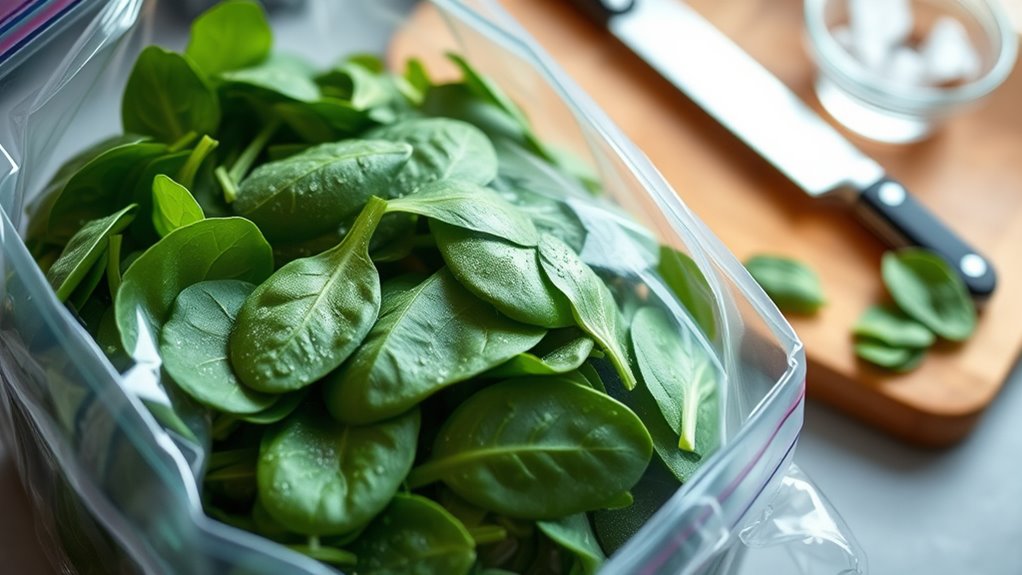
For long-term preservation of spinach, freezing is a great option that maintains its nutritional value and flavor.
Start by washing the leaves thoroughly and sorting out any damaged ones. Blanching is optional but helps preserve the color and taste.
After drying the leaves to remove excess moisture, you can freeze them whole in airtight bags or purée them for use in smoothies and soups. Consider using silicone muffin trays for convenient portioning.
Always label your containers with the date and contents to keep track of freshness.
When you're ready to use frozen spinach, defrost it under lukewarm water and squeeze out any excess moisture. Use it immediately to avoid spoilage; don't re-freeze!
Frequently Asked Questions
Can I Eat Spinach Past Its Expiration Date?
You can eat spinach past its "best by" date if it's been stored properly.
Just make sure to inspect it first. If it looks dark, wet, or smells strong, it's best to toss it.
Older spinach might taste bitter or less flavorful, but you can still use it in cooked dishes or freeze it for later.
Always prioritize safety to avoid any risk of foodborne illness when considering older greens.
How Can I Tell if Spinach Has Gone Bad?
To tell if spinach has gone bad, check its appearance first. Fresh spinach is bright green; if you see yellow or dark spots, it's likely spoiled.
Feel the leaves; they should be tender and crisp, not slimy or soggy. Give it a sniff—fresh spinach has little odor, while a musty smell indicates spoilage.
If you notice excess moisture, that's a bad sign too. When in doubt, it's safer to toss it out!
Is It Safe to Store Spinach With Other Vegetables?
When it comes to storing spinach with other veggies, you might want to think twice. Mixing them can be a recipe for disaster!
Spinach has specific moisture and ethylene sensitivity that can lead to quicker spoilage. To keep your greens in tip-top shape, it's best to store spinach separately.
This way, you'll avoid cross-contamination and maintain their freshness longer, ensuring you enjoy every bite without worry.
Can I Freeze Spinach Without Blanching It First?
Yes, you can freeze spinach without blanching it first. This method retains more nutrients and saves time.
Just wash and dry the leaves, then place them in freezer bags, removing as much air as possible before sealing.
Keep in mind that while it'll stay usable for about a month, some color and texture may change over time.
Use frozen spinach in smoothies or cooked dishes for added convenience and nutrition.
What Is the Best Temperature for Storing Spinach?
The best temperature for storing spinach is around 32°F, which helps slow down its decay.
While your refrigerator usually sits at about 40°F, it can still effectively preserve nutrients.
However, remember that higher temperatures lead to quicker nutrient loss, especially folate and carotenoids.
If you want to retain more nutrients long-term, consider freezing spinach, as it keeps better and lasts much longer than fresh spinach in the fridge.
Conclusion
By following these simple storage hacks, you'll not only keep your spinach fresh longer but also enjoy its vibrant flavor and nutrients in every meal. It's funny how a little extra care can lead to such delicious results. You might find that your salads taste more vibrant, or that your smoothies pack a bigger punch. Who knew that a few storage tweaks could turn your kitchen into a haven for fresh greens? Keep experimenting, and savor the difference!

